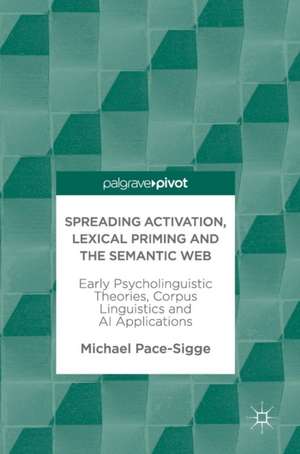Spreading Activation, Lexical Priming and the Semantic Web: Early Psycholinguistic Theories, Corpus Linguistics and AI Applications
Autor Michael Pace-Siggeen Limba Engleză Hardback – 15 iun 2018
Preț: 384.70 lei
Nou
Puncte Express: 577
Preț estimativ în valută:
73.61€ • 76.86$ • 60.79£
73.61€ • 76.86$ • 60.79£
Carte tipărită la comandă
Livrare economică 15-29 aprilie
Preluare comenzi: 021 569.72.76
Specificații
ISBN-13: 9783319907185
ISBN-10: 3319907182
Pagini: 136
Ilustrații: XIII, 135 p. 15 illus.
Dimensiuni: 148 x 210 mm
Greutate: 0.34 kg
Ediția:1st ed. 2018
Editura: Springer International Publishing
Colecția Palgrave Pivot
Locul publicării:Cham, Switzerland
ISBN-10: 3319907182
Pagini: 136
Ilustrații: XIII, 135 p. 15 illus.
Dimensiuni: 148 x 210 mm
Greutate: 0.34 kg
Ediția:1st ed. 2018
Editura: Springer International Publishing
Colecția Palgrave Pivot
Locul publicării:Cham, Switzerland
Cuprins
Chapter 1: Introduction.- Chapter 2: M. Ross Quillian, priming, spreading-activation and the semantic web.- Chapter 3: Where corpus linguistics and artificial intelligence (AI) meet.- Chapter 4: Take home messages for linguists and artificial intelligence designers.- Chapter 5: Conclusions.
Notă biografică
Michael Pace-Sigge is Senior Lecturer at the University of Eastern Finland, Finland. His key areas of research are corpus linguistics and lexical priming. He is the author of Lexical Priming in Spoken English Usage (2013) and co-editor of Lexical Priming: Advances and Applications (2017).
Textul de pe ultima copertă
This book explores the interconnections between linguistics and Artificial Intelligence (AI) research, their mutually influential theories and developments, and the areas where these two groups can still learn from each other. It begins with a brief history of artificial intelligence theories focusing on figures including Alan Turing and M. Ross Quillian and the key concepts of priming, spread-activation and the semantic web. The author details the origins of the theory of lexical priming in early AI research and how it can be used to explain structures of language that corpus linguists have uncovered. He explores how the idea of mirroring the mind’s language processing has been adopted to create machines that can be taught to listen and understand human speech in a way that goes beyond a fixed set of commands. In doing so, he reveals how the latest research into the semantic web and Natural Language Processing has developed from its early roots. The book moves on to describe how the technology has evolved with the adoption of inference concepts, probabilistic grammar models, and deep neural networks in order to fine-tune the latest language-processing and translation tools. This engaging book offers thought-provoking insights to corpus linguists, computational linguists and those working in AI and NLP.
Michael Pace-Sigge is Senior Lecturer at the University of Eastern Finland, Finland. His key areas of research are corpus linguistics and lexical priming. He is the author of Lexical Priming in Spoken English Usage (2013) and co-editor of Lexical Priming: Advances and Applications (2017).
Caracteristici
Offers an original contribution to the field by bringing together corpus linguistics, Natural Language Processing and lexical priming Demonstrates how linguists and AI engineers can learn from each other Shows how linguistics has allowed the development of cutting-edge technology
